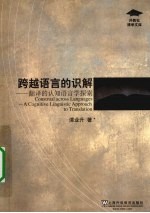
- 作 者:谭业升著
- 出 版 社:上海:上海外语教育出版社
- 出版年份:2009
- ISBN:9787544613712
- 标注页数:222 页
- PDF页数:238 页
请阅读订购服务说明与试读!
订购服务说明
1、本站所有的书默认都是PDF格式,该格式图书只能阅读和打印,不能再次编辑。
2、除分上下册或者多册的情况下,一般PDF页数一定要大于标注页数才建议下单购买。【本资源238 ≥222页】
图书下载及付费说明
1、所有的电子图书为PDF格式,支持电脑、手机、平板等各类电子设备阅读;可以任意拷贝文件到不同的阅读设备里进行阅读。
2、电子图书在提交订单后一般半小时内处理完成,最晚48小时内处理完成。(非工作日购买会延迟)
3、所有的电子图书都是原书直接扫描方式制作而成。
Chapter 1 Introduction and Overview 1
Chapter 2 Toward a Cognitive Model of Meaning Construction in Translation 11
2.1 Introduction 11
2.2 Two Cognitive Constructivist Approaches to Translation 12
2.2.1 The Relevance theory of translation 12
2.2.2 A Schema-theoretic view of translation 16
2.2.3 Correlation between the Relevance theory of translation and the Schema-theoretic view of translation 22
2.2.4 An explanatory frame:Three cognitive principles governing translation in a sequence of priority 24
2.3 A Cognitive Linguistic View of Meaning Construction and Translation 27
2.3.1 What is cognitive linguistics? 27
2.3.2 The interaction between language and cognition in meaning construction in translation 32
2.3.3 Language schemata redefined and the sanctioning effects of linguistic conventions in translation 36
2.3.4 On-line construal in language use and translation 40
2.4 A Cognitive Model of Meaning Construction in Translation 43
Chapter 3 Domain Conceptualization and Ground Construal in Translation 49
3.1 Domain Conceptualization and Ground Construal 49
3.1.1 Cognitive domains 50
3.1.2 Ground 52
3.2 Construal and Cognitive Abilities 52
3.3 Image Transformations/Construal Shifts in Meaning Construction and the lmplications for Translation 54
3.4 The Methodology of Investigating Translational Shifts and Variations 59
3.4.1 Descriptive Translation Studies vs.Prescriptive Translation Studies 59
3.4.2 Comparative analytical method of the DTS 61
3.5 Translational Shifts and Variations along Different Dimensions of Construal 66
3.5.1 Base/profile organization 66
3.5.2 Level of specificity(abstraction) 71
3.5.3 Subjectivity vs.objectivity 74
3.5.4 Perspective 78
3.5.5 Prominence:figure/ground organization 90
3.5.6 Interaction between different construal operations 93
3.6 Summary 94
Chapter 4 Image Schematic,Metonymic and Metaphorical Construal in Translation 97
4.1 Image Schema and Image Schematic Transformations in Translation 98
4.2 Metonymic Construal in Translation 101
4.2.1 Atraditional view of metonymy and metonymy translation 101
4.2.2 Metonymy in cognitive linguistics and in translation 104
4.2.3 Interim summary 118
4.3 Metaphorical Construal in Translation 119
4.3.1 A brief review of metaphor translation study in the past 119
4.3.2 A cognitive linguistic view of metaphor and metaphor translation 122
Case study 1:Strategies ofemotional metaphor translation 126
Case study 2:The systematic use of heart metaphors in Scarlet Letter and its Chinese translation 136
4.4 Summary 150
Chapter 5 Language Schemata,Preferred Construal Patterns,and Cognitive Changes in Translation 152
5.1 Language Schemata and Preferred Construal Patterns 152
5.2 Image-Schema-Based Preferred Construal Patterns 154
5.3 Figure/Ground Construal and Animacy 160
5.4 The Sanctioning Effects of Preferred Construal Patterns in Translation 165
Chapter 6 Cognitive Styles of Translation 168
6.1 Introduction:A Formula of Cognitive Style 168
6.2 The Coherence of Construal Operations in Fu Donghua's Translation ofGone with the Wind 169
6.3 Metaphoncal Coherence in Tess ofthe D'Urbervilles and Its Translation 174
6.4 The Cognitive Styles of Pound and Yip's Chinese Poetry Translation 178
6.4.1 A critical review on the syntactic analysis of classical Chinese poetry and its translation 179
6.4.2 Pound and Yip's aesthetics of Chinese poetry and its translation 182
6.4.3 The correlation between Pound and Yip's aesthetic principles and construal operations 186
6.4.4 The preferred construal configuration of Chinese poetics and Pound and Yip's cognitive styles of Chinese poetry translation 193
6.4.5 The transplanting issue 198
6.5 Conclusion 201
Chapter 7 Conclusion 204
7.1 Major Findings 204
7.2 Limitations and Directions for Future Study 205
Bibliography 209
Appendix:A glossary in Engish and Chinese 218
